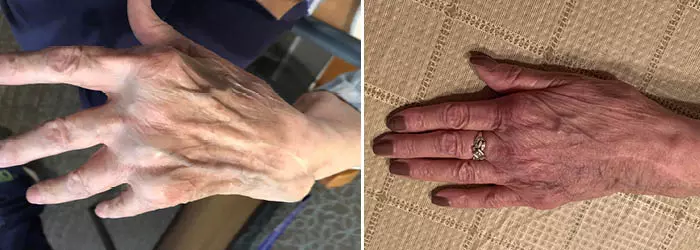- Home
- Patient Stories
- Rheumatoid Arthritis - Pam Dempewolf
Rheumatoid arthritis treated with knuckle replacement surgery
 Pamela Dempewolf is a retired ICU nurse and was diagnosed with rheumatoid arthritis over thirty years ago. “Ten years ago I had to give up my job because I was not able to provide bedside treatment due to the change in my hands.”
Pamela Dempewolf is a retired ICU nurse and was diagnosed with rheumatoid arthritis over thirty years ago. “Ten years ago I had to give up my job because I was not able to provide bedside treatment due to the change in my hands.”
A common symptom of rheumatoid arthritis is how it affects the hands. There is usually numbness and tingling, similar to the symptoms of carpal tunnel syndrome, and the joints in the wrist and fingers can become misshapen, warm and tender to the touch. It becomes difficult to use the fingers and thumb because of pain, deformity and weakness.
Pam’s rheumatoid arthritis had gotten so severe by the summer of 2019 that simple, everyday activities became very difficult. “I had difficulty washing my face. The deformity of my hands and the loss of strength in my hands made it hard to hold a washcloth.”
Frustrated with the deterioration of her hand function, Pam decided to do some research. “I thought, people get their joints replaced all the time. I’ve heard of hip, knee and shoulder replacements, and I wondered if there was an option for the joints in my hands.”
Several years prior, Pam had seen Martin Boyer, MD, a Washington University Orthopedics hand and microvascular surgery specialist at Barnes-Jewish Hospital. “I had an elbow injury in 2012 and saw Dr. Boyer. I thought he was great, so I made an appointment to talk to him about options for my hands.”
After meeting with Dr. Boyer, he recommended metacarpophalangeal replacement arthroplasties (in lay terms, knuckle replacement surgery). Dr. Boyer would replace the damaged joints in her hand with silicone polymer joint prostheses. The new silicone parts would allow Pam to use her hands again with less pain.
Pam’s right hand was worse than her left, so the first surgery was on her right hand in July of 2019. Dr. Boyer explains, "Pam had significant abnormalities in four of the joints of her hand that required a re-balancing of her tendons and ligaments, and replacement of the joints themselves.” After a quick recovery, Pam began preparing to repeat the operation on her left hand. Pam’s second surgery was originally scheduled for the spring of 2020, but was rescheduled for July because of COVID-19.
“I will never have my hands back to normal, but my hands and fingers are straighter and look better. I’ve had both knees replaced. Compared to that, the recovery for my hand surgeries was very easy.”

There is a striking difference in the structure of Pam's hands after knuckle replacement surgery; before surgery (left) and after surgery (right).
Dr. Boyer says, "The type of surgery that Pam had requires a real dedication to post-operative therapy and splinting. Pam worked diligently during the post-operative period, and she has had a really great result!”
Every eight weeks, Pam goes to infusion center at Barnes-Jewish St. Peters Hospital for treatment of her rheumatoid arthritis and says the nurses and other patients were impressed with her surgery and outcome. “After the first surgery, I showed them my hand and they could not believe how good it looked. The next time I went in, they told me they had told 2-3 other patients ask about it and referred them to Dr. Boyer.”
Pam says, “Dr. Boyer is great. I could not be happier. I would recommend him to anyone. He is so personable and so funny. I’ve spent a lot of time with him and he is very professional, but he’s also just fun to go see.”